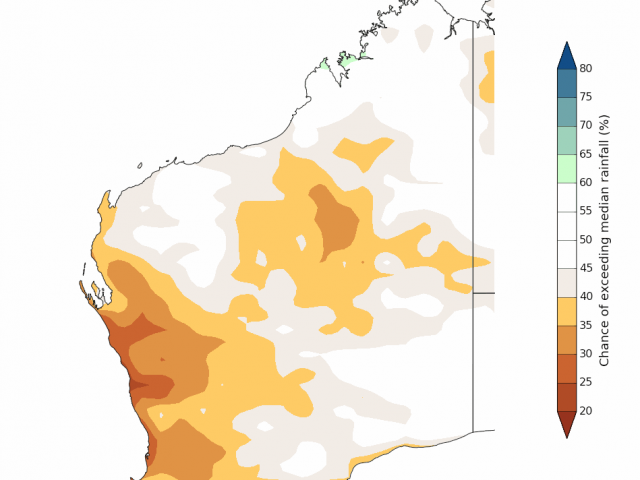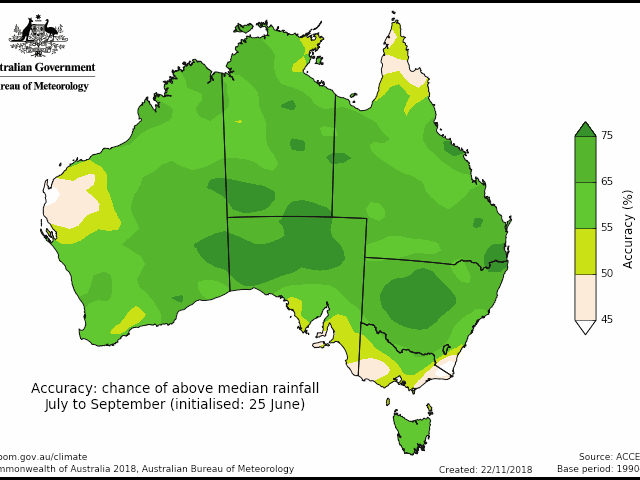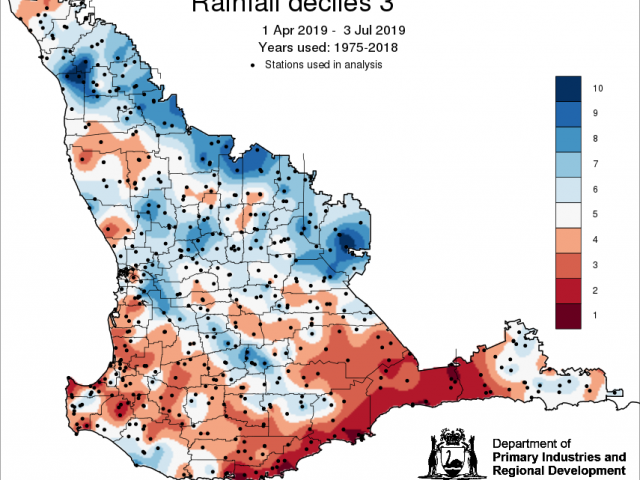Summary
The Department of Primary Industries and Regional Development’s (DPIRD) Statistical Seasonal Forecast (SSF) outlook for July to September 2019 is indicating neutral to wetter conditions for the South West land Division (SWLD). The outlook for July to October 2019 is mixed.
- For July to September 2019, the SSF is indicating neutral chance (40-60%) of exceeding median rainfall with higher chances (60-80%) for parts of the Central West, Central Wheatbelt, South West, South Coastal and South East Coastal districts. Predictive skill based on June conditions is poor to good (50 -70% consistent).
- For July to October, SSF is indicating a 60-80% chance of exceeding median rainfall for parts of the Central West, Central Wheatbelt and South East Coastal districts. Lower chances at 30-40% in western parts of the Great Southern district and neutral chance (40-60%) elsewhere. Predictive skill based on June conditions is poor to good (50 -70% consistent).
- The Bureau of Meteorology’s current seasonal outlook is indicating 20-50% chance of exceeding median rainfall for July to September 2019, for the South West Land Division. Predictive skill is poor to good (50-75% consistent).
- Temperature outlooks for July to September 2019, from the Bureau indicate a 45-55% (neutral) chance of above average day-time maxima for the SWLD. Skill is poor to moderate at 45-65% consistent. Minimum temperature outlooks indicate a 45-60% chance of above average night-time minima for the SWLD, with skill poor to moderate 45-65% consistent. With more cloud-free days and nights expected, there is an increase of frost in susceptible areas.
- June rainfall was very much above average (decile 9) for the majority of the SWLD, based on historical years of 1975-2018. However, parts of the South Coastal and South East Coastal districts, only received decile 2-3 rainfall for June. June maximum temperatures were average to above average and minimum temperatures were average.
- The Indian Ocean is currently the dominant influence on Australian climate, with an ENSO-neutral phase in the Pacific Ocean considered the most likely scenario for the remainder of winter and spring. A positive Indian Ocean Dipole (IOD) is forecast to persist through winter and into spring. A positive IOD typically brings below average rainfall to much of central and southern Australia during winter-spring.
Three Month Outlook for the south-west of Western Australia
Statistical Seasonal Forecasting (SSF)
DPIRD’s Statistical Seasonal Forecast (SSF) system uses historical relationships between global sea surface temperature and sea level pressure with rainfall in south-west Australia to produce forecasts of rainfall for the coming months. Users can click on any station indicated on the map for location-specific forecast information from the Seasonal Climate Information web page.
For July to September 2019, the SSF is indicating neutral chance (40-60%) of exceeding median rainfall with higher chances (60-80%) for parts of the Central West, Central Wheatbelt, South West, South Coastal and South East Coastal districts (as classified by the Bureau of Meteorology forecast districts). The most probable decile range is decile 8-10 for for parts of the Central West, Central Wheatbelt, South West, South Coastal and South East Coastal districts, and decile 4-7 elsewhere. Predictive skill based on June conditions is poor to good (50 -70% consistent).
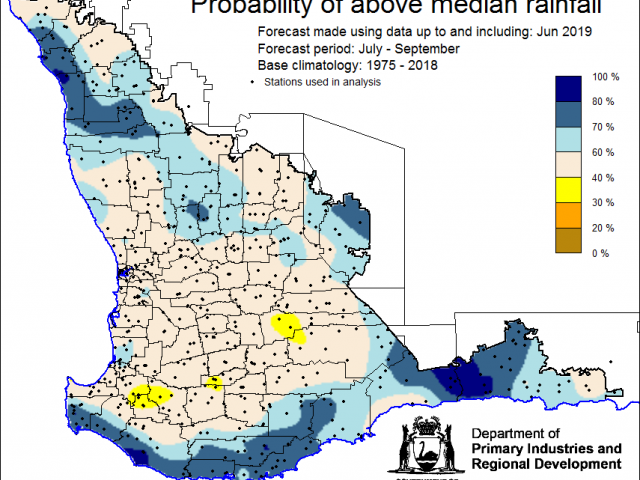
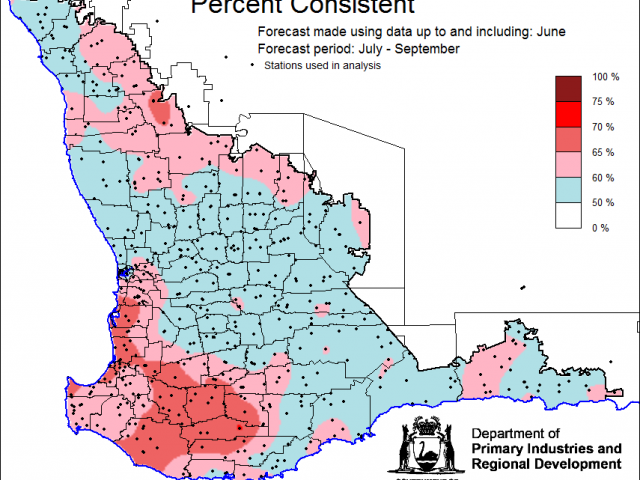
Bureau of Meteorology seasonal climate outlook
The Bureau of Meteorology's climate forecast system for monthly and seasonal climate outlooks is the Australian Community Climate Earth-System Simulator – Seasonal (ACCESS–S). It is a dynamical (physics-based) forecast modelling system and is a collaboration between the Bureau of Meteorology and the UK Meteorological Office.
The Bureau of Meteorology’s current seasonal outlook is indicating 20-50% chance of exceeding median rainfall for July to September 2019, for the South West Land Division. Predictive skill is poor to good (50-75% consistent).
Temperature outlooks for July to September 2019, from the Bureau indicate a 45-55% (neutral) chance of above average day-time maxima for the SWLD. Skill is poor to moderate at 45-65% consistent. Minimum temperature outlooks indicate a 45-60% chance of above average night-time minima for the SWLD, with skill poor to moderate 45-65% consistent. With more cloud-free days and nights expected, there is an increase of frost in susceptible areas.
 SSF July to October outlook
SSF July to October outlook
For July to October, the SSF is indicating a 60-80% chance of exceeding median rainfall for parts of the Central West, Central Wheatbelt and South East Coastal districts. Lower chances at 30-40% for western parts of the Great Southern district and neutral chance (40-60%) elsewhere (as classified by the Bureau of Meteorology forecast districts). The most probable decile range is decile 2-3 for western parts of the Great Southern district, decile 8-10 for parts of the Central West, Central Wheatbelt and South East Coastal districts and decile 4-7 elsewhere. Predictive skill based on June conditions ranges from poor to good (50 -70% consistent) depending on location.
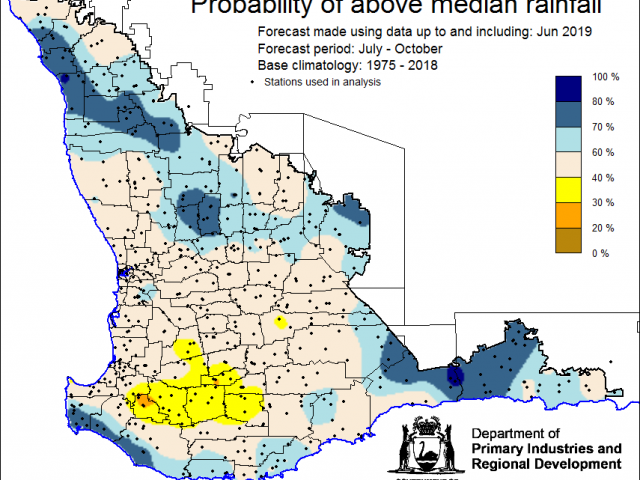
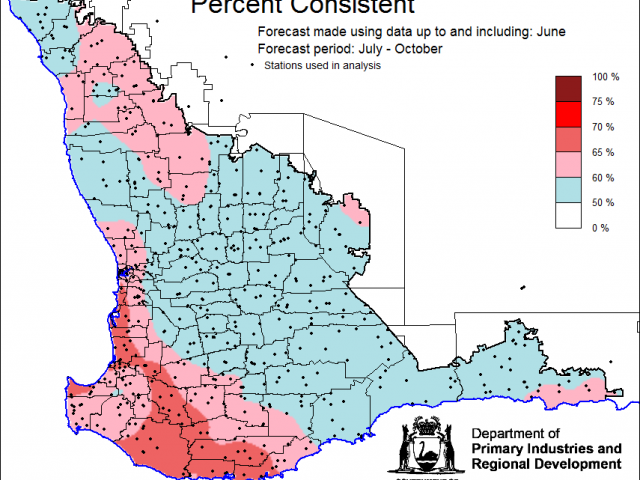
Recent climate
June rainfall was above average (decile 8 or better) for the much of the SWLD. However, parts of the South Coastal and South East Coastal districts, only recieved decile 2-3 rainfall for June. June maximum temperatures were average to above average and minimum temperatures were average.
Rainfall since 1 April has been generally above decile 5 for the SWLD, but below decile 3 for some parts of the South Coastal and South East Coastal districts.
In June, the atmospheric pressure was near normal over the SWLD, allowing cold fronts to pass-over. However, in the coming months, higher than average pressure is likely over southern and eastern Australia. This can act to suppress cloud formation and to keep cold fronts further south than normal, thereby reducing rainfall for the southern states.
Indian Ocean sea surface temperatures off the WA coastline have been cooler than average. The July to September SST forecast by the Bureau of Meteorology indicates SSTs are likely to be near normal north of WA.
The Southern Annular Mode (SAM), also known as the Antarctic Oscillation (AAO), describes the north–south movement of the westerly wind belt that circles Antarctica, dominating the middle to higher latitudes of the southern hemisphere. For June, SAM was positive. In a positive SAM phase, the belt of westerly winds contracts towards Antarctica. This results in weaker than normal westerly winds and higher pressures over southern Australia, restricting the passage of cold fronts inland.
In the Indian Ocean, waters remain average to cooler than average in eastern parts, and warmer than average further west; a pattern typical of a positive Indian Ocean Dipole (IOD). While the IOD index fell below the positive IOD threshold this week, climate models indicate this is likely to be temporary, with positive IOD values forecast to persist through winter and into spring. Typically, a positive IOD brings below average winter-spring rainfall, above average temperatures, and an earlier start to the fire season for southern and central Australia.
The Bureau's ENSO Outlook is currently INACTIVE. While the possibility of El Niño cannot be completely ruled out for 2019, the tropical Pacific Ocean is likely to remain neutral over the coming months. For further information, see the Bureau of Meteorology’s ENSO Wrap Up.
The table below gives a summary of past month and three-month South West Land Division (SWLD) climate conditions, and can indicate what is likely to occur in the near future if climate conditions follow the current pattern.
| Climate indicator | Past month | Past 3 months |
|---|---|---|
| SWLD Rainfall | Above average | Below average |
| SWLD Mean Temperature | Average | Average |
| SWLD atmospheric pressure | Near Normal | Above Normal |
| Indian Ocean Sea surface temperature | Cooler | Cooler |
| El Niño/Southern Oscillation (ENSO) | Neutral | Neutral |
| Indian Ocean Dipole (IOD) | Positive | Neutral |
| Southern Annular Mode (SAM) | Positive | Neutral |

